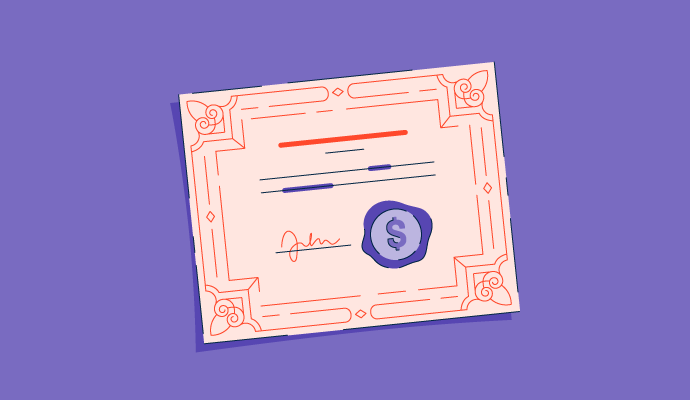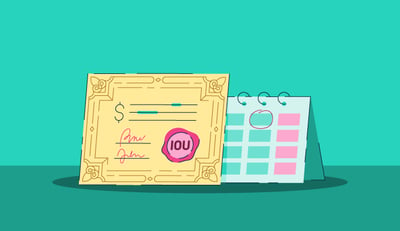March 14, 2024
 by Holly Landis / March 14, 2024
by Holly Landis / March 14, 2024

Borrowing and lending money are something most of us do at some point in our lives. Whether it’s through a formal loan with a bank or among friends or family, a record of the loan helps make sure that all the lender is eventually repaid.
A verbal agreement isn’t enough if large sums of money are exchanged informally, like when loaning your sibling some cash for a car or helping a friend out with rent. Instead, a legal document like a promissory note can keep both parties accountable for their roles in the deal.
A promissory note is a legally-binding contract wherein one party promises to pay another party a set sum of money, either on a recurring basis or in full, by a certain date. The note contains all of the details about the loan, such as the amount, the interest on the loan, the maturity date, and the payment schedule.
The lender doesn’t have to sign the promissory note, but the borrower does because it’s the written record that they are promising to pay the money back. Since a promissory note is legally enforceable, it’s important that all of the details are correct before the borrower signs it.
Even if the loan is among friends or relatives, working with an attorney is the best course. They use legal document drafting software to ensure that relevant details are in the contract and contain the necessary signatures to make the promissory note binding.
Any kind of financial lending can use promissory notes, either as standalone documents or as part of the paperwork needed when borrowing large sums of money for big ticket items. Both personal lending and business transactions use promissory notes to provide the lender with legal protections.
Some of the most common uses for promissory notes are:
Many people choose not to use promissory notes when loaning money to friends and family, even for a lot of cash. However, this is a risky move and there’s no guarantee you’ll see that money again. And without a promissory note, there’s nothing you can do if they don’t repay you.
For small amounts, a note is usually not necessary. But for money that you’d miss if you didn’t get it back, a promissory note solves the issue well.
Depending on the type of loan, you need different types of promissory notes to set the repayment terms for the borrower.
This is the most basic type of promissory note and is generally used for smaller loan amounts with a single borrower. If two individuals are exchanging money, all they need is a simple note. The details included in a simple promissory note can be as stripped down as the amount, the terms of the repayment, the payment schedule, and the names of those involved.
An open-ended promissory is more like a line of credit than a traditional loan. Borrowers only receive a portion of the full amount upfront, but they can take additional money later if they need more while paying back the original amount borrowed. This can be easier to manage than taking out multiple loans with different promissory notes.
If a borrower needs multiple loans, they and the lender can use a master promissory note as an ongoing agreement. This can cover several loans between the same parties for a given amount of time, like individual student loans.
A secured promissory note typically comes with better interest rates than yhe other kinds because something of value needs to be put down as collateral as part of the loan. If the borrower fails to repay the money, this secured note allows the lender to take possession of the collateral in lieu of the payment balance.
Unsecured promissory notes don’t require the borrower to put down any collateral, but there are still legal options for the lender should the borrower not make their repayments.
These promissory notes are common in real estate transactions, as the mortgage is used to secure the loan, rather than any additional collateral. If the mortgage isn’t repaid, a lien can be put on the property that allows the lender to foreclose on it and recoup their money.
The basic elements of a contract should also be included in a promissory note. Additional details may be needed depending on the type of note, but at minimum, a promissory note should contain:
If you use a secured promissory note, you must include details on the collateral. Master promissory notes also have more intricate information about how long the note is good and which type of loan it covers.
Much like a traditional loan agreement, borrowers can repay in several ways. Along with lump sum and installment, you also have due on demand and balloon payments.
Promissory notes may feel like an unnecessary step, especially if you’re lending or borrowing a small amount or it’s just between friends. But keeping everyone legally protected is important, so put it on paper with the help of legal documentation drafting tools that make exchanging money quick and simple.
Trying to sign a promissory note with someone far away or simply looking for an easier way to digitize the process? With e-filing platforms, completing legal documents has never been easier.
Holly Landis is a freelance writer for G2. She also specializes in being a digital marketing consultant, focusing in on-page SEO, copy, and content writing. She works with SMEs and creative businesses that want to be more intentional with their digital strategies and grow organically on channels they own. As a Brit now living in the USA, you'll usually find her drinking copious amounts of tea in her cherished Anne Boleyn mug while watching endless reruns of Parks and Rec.
Keeping track of what your business owes, and when payments are due, is critical to staying...
 by Holly Landis
by Holly Landis
Debt can be scary when you’re paying off college loans or deciding whether to use credit to...
 by Maddie Rehayem
by Maddie Rehayem
All small businesses and startups began with a great idea. For many, the next step was to...
 by Maddie Rehayem
by Maddie Rehayem
Keeping track of what your business owes, and when payments are due, is critical to staying...
 by Holly Landis
by Holly Landis
Debt can be scary when you’re paying off college loans or deciding whether to use credit to...
 by Maddie Rehayem
by Maddie Rehayem


